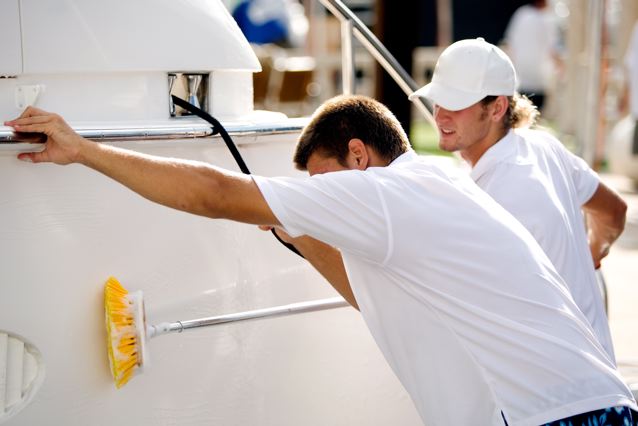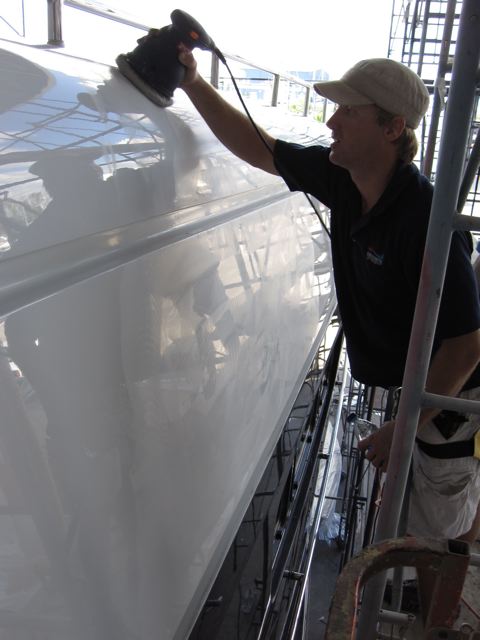What good mother would send her child out into the blistering sun without sunscreen on? Alright babies and boats aren’t apples to apples but summer is here and there’s no better time than now to protect your vessel’s gel-coat and painted surfaces from the harsh weather elements that exist.
When a yachts gel-coat or painted surfaces are left unprotected deterioration quickly starts to take place at a micro-level causing the surface to becomes porous and rot. Shine is immediately taken away and the vessel’s gel-coat or paint begins to haze, taking on a flat color. The porosity of the surface catches more dirt preventing it from sliding off your boat thus requiring much more cleaning and work. The good news is almost all gel-coated surfaces and painted surfaces can be restored, given there is still dept and it hasn’t been worn through.

It’s imperative that the restoration and maintenance of your vessel’s cosmetics surfaces follow certain steps pertaining to products and application techniques. Having the wrong product or application method can cause swirl marks, waste time, heaps of money and or destroy your vessel’s paint job. Below are a few tips we’ve learned over the years having mastered this process.
Step #1-THOROUGH VESSEL WASH DOWN
Using an aggressive soap/cleaner give the yacht a thorough wash down and good chamois. This will guarantee a clean surface and keep dirt from clogging up your wool buffing bonnets.
Remember you want to remove dirt when polishing your boat not move dirt so make sure your brushes, pads and micro-fiber are always clean and fresh!!
Many time people think because they are compounding first or cutting off the top millimeter that it doesn’t make a difference to wash it.. it does and wool pads are expensive so give it a good wash first.
Step #2-COMPOUNDING, MICRO-FINISHING AND WAXING

If you’ve ever seen an old piece of wood being sanded down to a beautiful finish you know that the process requires several steps and usually starts with a rough sandpaper to remove the dead (grey) wood and then a medium grit sand paper to minimize the heavy scratches creating smoothness and then a light sandpaper to fully remove light scratches thus creating a friction less substrate before a polyurethane sealer is applied as a last step to protect the wood from the wind and rain.
The same principles apply when finishing gel coat and paint except our sand paper comes in the form of liquid compound laden with chunkier minerals for heavy (coarse) cut and lighter minerals for (lighter) cut. Our wax is usually a silicon polymer for pure protection.
To properly finish gel coat or painted surface you must start with the most aggressive grit compound needed to fully remove the dead surface and restore color and clarity after which (like finishing wood) you stage down moving to lighter compounds that will remove scratches and bring shine and clarity before applying a topcoat or wax to seal and protect the surface.
Most times this is a multi step process unless the boat’s gel coat or paint is brand new and or has been perfectly maintained and needs just a coat of protective wax.
The 1st cleaning compound used will depend on the amount of oxidization or fade your vessel’s surface has. A heavy haze (chalky look) will require a heavy cut compound, a medium haze (cloudy look) will require a medium cut compound and a light haze (misty looking) will require a light cut compound to restore to fresh paint and gel-coat look, shine and appearance. After which an application of topcoat or wax is applied to seal the surface and keep out the elements.
PRO ADVICE: For each step or type of compound used a different texture of buffing pad is needed-Heavy duty compound requires a white (course) wool buffing pad-Medium and light compound requires a yellow- (medium) texture wool buffing pad. Foam pads are HIGHLY recommended when finishing dark color yacht paint and are of different texture depending on color. Apply wax with hand orbital, remove by hand and polish at slow speed with a perfectly clean soft buffing pad.
NOTE: Use a spur (cleaning tool or rake stick) to clean your pads frequently when polishing as residue will build up and cause swirls and burn marks, when your pad has tight short dread locks it’s done**Product knowledge and application technique is what separates the pros from the bums**ohh yeah don’t exceed 3000 rpm on your machine and apply even steady pressure in 3 foot horizontal and vertical motions when buffing.
PRODUCTS: The 3m finishing system has been the leading paint and gel coat finishing system over the years. It flat out works! Presta products out of Miami deliver an excellent, comparable line of product that are water based (no fillers) and a bit cheaper.
Please commment to let us know what steps and products work best for you!




